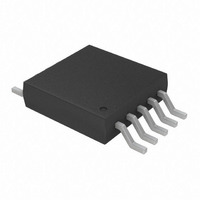TC654EUN Microchip Technology, TC654EUN Datasheet - Page 12

TC654EUN
Manufacturer Part Number
TC654EUN
Description
IC PWM FAN SPEED CTRLR 10-MSOP
Manufacturer
Microchip Technology
Type
High Speed PWM Controllerr
Datasheet
1.TC654EUN.pdf
(36 pages)
Specifications of TC654EUN
Number Of Outputs
1
Package / Case
10-MSOP, Micro10™, 10-uMAX, 10-uSOP
Applications
Fan Controller, Brushless (BLDC)
Voltage - Supply
3 V ~ 5.5 V
Operating Temperature
-40°C ~ 85°C
Mounting Type
Surface Mount
Output Current
5 mA (Min)
Operating Supply Voltage
3 V to 5.5 V
Maximum Operating Temperature
+ 85 C
Minimum Operating Temperature
- 40 C
Mounting Style
SMD/SMT
Motor Type
PWM
No. Of Outputs
1
Output Voltage
4.4V
Supply Voltage Range
3V To 5.5V
Driver Case Style
MSOP
No. Of Pins
10
Operating Temperature Range
-40°C To +85°C
Rohs Compliant
Yes
Lead Free Status / RoHS Status
Lead free / RoHS Compliant
Current - Output
-
Voltage - Load
-
Lead Free Status / Rohs Status
Lead free / RoHS Compliant
Available stocks
Company
Part Number
Manufacturer
Quantity
Price
Part Number:
TC654EUN
Manufacturer:
MIC
Quantity:
20 000
Part Number:
TC654EUNTR
Manufacturer:
MICROCHIP/微芯
Quantity:
20 000
TC654/TC655
FIGURE 4-6:
Network.
The second method for controlling the duty cycle of the
PWM output (V
to control the PWM duty cycle via the SMBus, DUTYC
(bit 5<0>) of the Configuration Register (Register 6.3)
must be set to a ‘1’. This tells the TC654/TC655 device
that the duty cycle should be controlled by the Duty
Cycle Register. Next, the Duty Cycle Register must be
programmed to the desired value. The Duty Cycle Reg-
ister is a 4 Bit read/write register that allows duty cycles
from 30% to 100% to be programmed. Table 4-1 shows
the binary codes for each possible duty cycle.
TABLE 4-1:
DS21734A-page 12
D(3)
0
0
0
0
0
0
0
0
1
1
1
1
1
1
1
1
34.8 k
14.7 k
D(2)
R
R
0
0
0
0
1
1
1
1
0
0
0
0
1
1
1
1
Duty-Cycle Register (Duty Cycle)
1
2
+5 V
OUT
D(1)
DUTY-CYCLE REGISTER
(DUTY-CYCLE) 4-BITS,
READ/WRITE
) is via the SMBus interface. In order
0
0
1
1
0
0
1
1
0
0
1
1
0
0
1
1
NTC Thermistor Sensor
C
0.01 µF
D(0)
NTC Thermistor
100 k
0
1
0
1
0
1
0
1
0
1
0
1
0
1
0
1
1
30%
34.67%
39.33% (default for V
open and when SMBus
is not selected)
44%
48.67%
53.33%
58%
62.67%
67.33%
72%
76.67%
81.33%
86%
90.67%
95.33%
100%
@ 25°C
GND
V
IN
Duty-Cycle
TC654/
TC655
IN
This method of control allows for more sophisticated
algorithms to be implemented by utilizing microcontrol-
lers or microprocessors in the system. In this way, mul-
tiple system temperatures can be taken into account for
determining the necessary fan speed.
As shown in Table 4-1, the duty cycle has more of a
step function look than did the V
Because the step changes in duty cycle are small, they
are rarely audibly noticeable, especially when the fans
are integrated into the system.
4.6
The V
transistors or N-channel MOSFETs as the low side
power switching elements in the system as is shown in
Figure 4-7. These switching elements are used to turn
the fans on and off at the PWM duty cycle commanded
by the V
This output has complementary drive (pull up and pull
down) and is optimized for driving NPN transistors or
N-channel MOSFETs (see Section 2.0 for sink and
source current capability of the V
The external device needs to be chosen to fit the volt-
age and current rating of the fan in a particular applica-
tion (Refer to Section 7.5 Output Drive Device
Selection). NPN transistors are often a good choice for
low current fans. If a NPN transistor is chosen, a base
current limiting resistor should be used. When using a
MOSFET as the switching element, it is sometimes a
good idea to have a gate resistor to help slow down the
turn on and turn off of the MOSFET. As with any switch-
ing waveform, fast rising and falling edges can
sometimes lead to noise problems.
As previously stated, the V
duty cycle during power up and release from shutdown
conditions. The V
commanded to do so via the Configuration Register
(SDM (bit 0<0>)). Even when a locked rotor condition
is detected, the V
the programmed duty cycle.
4.7
The TC654 and TC655 also feature Microchip's propri-
etary FanSense technology. During normal fan opera-
tion, commutation occurs as each pole of the fan is
energized. The fan current pulses created by the fan
commutation are sensed using low value current sense
resistors in the ground return leg of the fan circuit. The
voltage pulses across the sense resistor are then AC
coupled through capacitors to the SENSE pins of the
TC654/TC655 device. These pulses are utilized for cal-
culating the RPM of the individual fans. The threshold
voltage for the SENSE pins is 100 mV (typical). The
peak of the voltage pulse at the SENSE pins must
exceed the 100 mV (typical) threshold in order for the
pulse to be counted in the fan RPM measurement.
OUT
OUT
PWM Output (V
Sensing Fan Operation (SENSE1 &
SENSE2)
pin is designed to drive two low cost NPN
output.
OUT
OUT
output will continue to pulse at
output only shuts down when
2002 Microchip Technology Inc.
OUT
OUT
output will go to 100%
OUT
IN
)
control approach.
drive stage).













